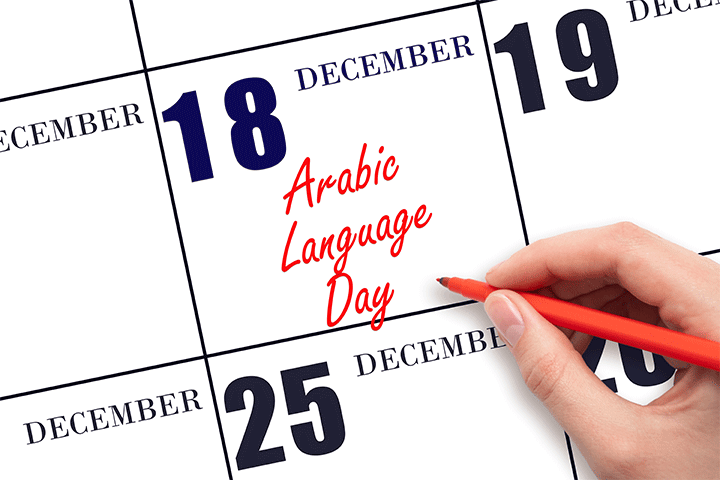Welcome to an essential lesson for navigating daily life in the Arab world: understanding dates in Arabic! Whether you’re planning a trip, reading a newspaper, or just trying to figure out “today’s date in Arabic,” mastering how to express dates is incredibly useful. In Arabic, “date” can refer to both a calendar date and the sweet fruit, so let’s clarify that first! This guide will teach you the nuances of saying the date in Arabic, show you how to write date in Arabic, and help you confidently state your date of birth in Arabic.
“Date” in Arabic: More Than Just a Number!
Before we delve into calendar dates, it’s important to know the two main Arabic words that translate to “date” in English:
- (taareekh) تَارِيخ : This is the word for a calendar date, or history.
- (tamr) تَمْر : This is the word for the sweet fruit (dates).
- Cultural Note: Dates (the fruit) are highly significant in Arab culture, especially during Ramadan.
Throughout this article, when we say “date in Arabic,” we are referring to the calendar concept.
Gregorian Calendar: Days, Months, and Years
Most Arab countries use the Gregorian calendar alongside the Islamic (Hijri) calendar. Here’s how to talk about its components:
Days of the Week (أَيَّام الْأُسْبُوع – Ayyām al-ʾUsbūʿ):
- Sunday – الأَحَد (al-ʾAḥad)
- Monday – الاِثْنَيْن (al-Ithnayn)
- Tuesday – الثُّلَاثَاء (ath-Thulāthāʾ)
- Wednesday – الأَرْبِعَاء (al-ʾArbiʿāʾ)
- Thursday – الخَمِيس (al-Khamīs)
- Friday – الجُمُعَة (al-Jumuʿah)
- Saturday – السَّبْت (as-Sabt)
Months of the Year (شُهُور السَّنَة – Shuhūr as-Sanah):
Arabic-speaking countries often use different sets of names for the Gregorian months. The two most common systems are the Levantine/Iraqi system (closer to original Latin names) and the Gulf/Egyptian system (more direct transliterations).
Here are the most common Arabic names for Gregorian months:
| English | Levantine/Iraqi Common | Gulf/Egyptian Common |
|---|---|---|
| January in Arabic | كَانُون الثَّانِي (Kānūn ath-Thānī) | يَنَايِر (Yanāyir) |
| February in Arabic | شُبَاط (Shubāṭ) | فَبْرَايِر (Fabrāyir) |
| March in Arabic | آذَار (ʾĀdhār) | مَارِس (Māris) |
| April in Arabic | نَيْسَان (Naysān) | أَبْرِيل (ʾAbrīl) |
| May in Arabic | أَيَّار (ʾAyyār) | مَايُو (Māyū) |
| June in Arabic | حُزَيْرَان (Ḥuzayrān) | يُونْيُو (Yūnyū) |
| July in Arabic | تَمُّوز (Tammūz) | يُولْيُو (Yūlyū) |
| August in Arabic | آب (ʾĀb) | أَغُسْطُس (ʾAghusṭus) |
| September in Arabic | أَيْلُول (ʾAylūl) | سِبْتَمْبَر (Sibtambar) |
| October in Arabic | تِشْرِين الْأَوَّل (Tishrīn al-ʾAwwal) | أُكْتُوبَر (ʾUktūbar) |
| November in Arabic | تِشْرِين الثَّانِي (Tishrīn ath-Thānī) | نُوفَمْبَر (Nūfambar) |
| December in Arabic | كَانُون الْأَوَّل (Kānūn al-ʾAwwal) | دِيسَمْبَر (Dīsambar) |
How to Write Date in Arabic: Formatting
The standard way to write the date in Arabic for the Gregorian calendar is usually Day (number) – Month (name) – Year (number).
Today’s Date in Arabic (تاريخ اليوم – Tārīkh al-Yawm):
To ask “today’s date in Arabic,” you can say:
- What is today’s date? – مَا هُوَ تَارِيخ الْيَوْم؟ (Mā huwa tārīkh al-yawm?)
And for today’s date (June 2, 2025):
- تَارِيخ الْيَوْم هُوَ 2 يُونْيُو 2025 (Tārīkh al-yawm huwa 2 Yūnyū 2025.) – Today’s date is June 2, 2025.
The Islamic (Hijri) Calendar: An Important System
The Islamic or Hijri calendar (التَّقْوِيم الْهِجْرِيّ – at-Taqwīm al-Hijrī) is a lunar calendar and is highly significant in the Arab and Muslim world. It began with the Hijra (migration) of Prophet Muhammad (peace be upon him) from Mecca to Medina in 622 CE.
- Usage: Used for religious holidays, festivals, and official documents in some countries (e.g., Saudi Arabia).
- Months: It has 12 lunar months, each lasting 29 or 30 days.
While the Gregorian calendar is used for civil purposes, knowing about the Hijri calendar is crucial for understanding religious and cultural events.
Your Date of Birth in Arabic
Asking and stating your date of birth in Arabic is a common and useful phrase:
- When were you born? (to a male) – مَتَى وَلَدْتَ؟ (Matā waladta?)
- When were you born? (to a female) – مَتَى وَلَدْتِ؟ (Matā waladti?)
- My date of birth is… – تَارِيخ مِيلَادِي هُوَ… (Tārīkh mīlādī huwa…)
- Example: My date of birth is September 15, 1990. – تَارِيخ مِيلَادِي هُوَ 15 سِبْتَمْبَر 1990. (Tārīkh mīlādī huwa 15 Sibtambar 1990.) –
Tips for Mastering Dates in Arabic
- Practice Numbers: Make sure you’re comfortable with Arabic numbers, as they are fundamental to stating dates in Arabic.
- Memorize Months: Focus on the month names used in the region you’re most interested in, but be aware of the other system.
- Listen to News: Pay attention to how dates are announced on Arabic news channels.
- Use an Arabic Calendar: Keep an Arabic calendar (digital or physical) to familiarize yourself with the days and months.
Understanding dates in Arabic is a practical skill that deepens your connection to the language and culture. From casual conversations to official documents, knowing how to express the date in Arabic will serve you well.
Ready to confidently talk about “today’s date in Arabic” and much more? Visit www.kaleela.com and download the Kaleela Arabic learning app today! Our comprehensive lessons will help you master numbers, time, and all the essential vocabulary for fluent communication in Arabic!



